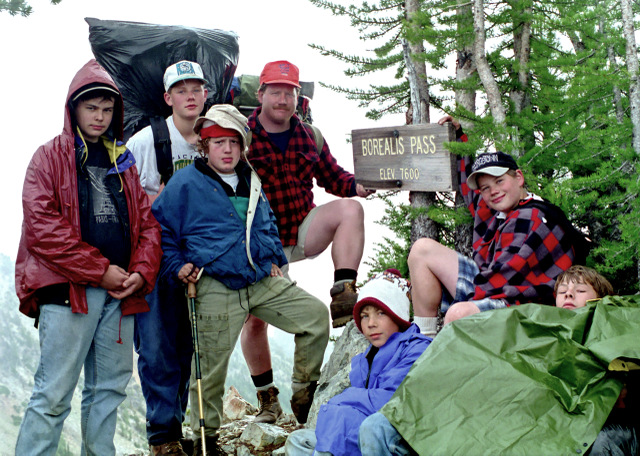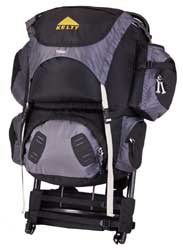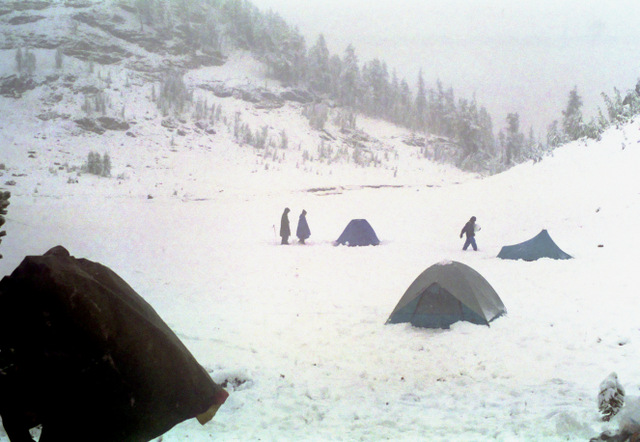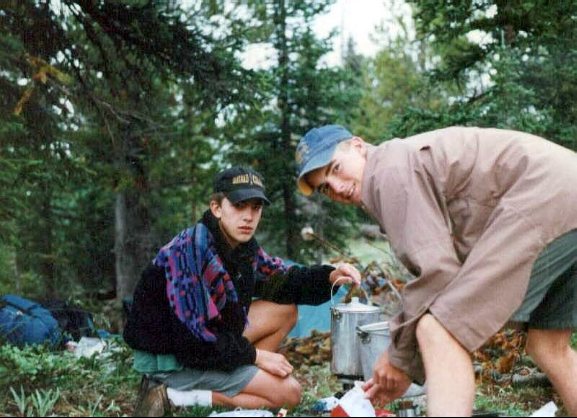
|
Troop 24 - The High Adventure Troop
Equipment: Thoughts to Consider
|

|
Troop 24 - The High Adventure Troop
Equipment: Thoughts to Consider
|
Scouting experiences can be very rewarding for a new scout. Monthly scout outings prepare the scout for extended High Adventure backpacking trips in later years as he gains more experience. Every summer the troop will try to offer a four day/ three night Mini-Miler to first year scouts. This type of trip is a good introduction to what may become a life-long hobby. It also gives the young scout an opportunity that will help teach self reliance and how to work with a group to meet any challenge that comes up.
|
Properly equipping a new scout can be fairly expensive: packs, sleeping bags, etc. are not cheap. Since you usually get what you pay for, the cheapest item may not be a bargain. I've seen kids with new packs or boots that fell apart before the had completed their first full trip. Quality used items can be a real cost saver. Value Village is a good place for reasonably priced items like wool or pile shirts or sweaters. Second hand sports stores sometimes have good items on hand, although these may be easier to find in December than June. |

Be Prepared For Anything
|
REI, Outdoor Emporium, and other local outdoor stores have good quality items for youth. Mail order outlets such as Campmor (www.campmor.com) and LL Bean (llbean.com) are very dependable with a good selection of equipment and outdoor clothing. Campmor has just about every conceivable item from tent pegs to portable toilets (Yes, I have seen a backpacker carrying a portable toilet seat - in almost 40 years of backpacking you see just about everything!)
Young scouts, especially, need light equipment. Unfortunately, there is an inverse relationship between the cost and weight of backpacking equipment - the lighter an item is, the more costly it becomes. Fortunately, it is the last few ounces that are the most expensive. Try to go as light as you can within your budget.
For instance, Don't buy a sleeping bag that weighs six pounds just to save a few dollars. For the type of backpacking the troop generally does, a +20 degree rated bag will be sufficient. Affordable lower temperature rated bags will probably be much too heavy for a young scout. On the rare very cold night, more layers of clothing can be added to increase the bag comfort rating.
|
There are a wide variety of backpacks available. Although both external frame and internal frame packs are available, I think it is wise to stick with an external frame pack for young scouts. There are less problems fitting the pack and they are usually cheaper. My personal favorite for a younger scout is the Kelty Yukon. The Yukon 48 has 2900 cu in capacity and fits a torso length of 13-19 inches. The Yukon 50 has 3000 cu in and fits a torso length of 16-21 inches. The Kelty Trekker (for 13-15 year olds) has a capacity of 3900 or 3950 (Trekker 64 and 65) and fits a torso length of 14-20 inches (Trekker 64) or 16-22 inches (Trekker 65). The Yukon distributes the weight well, has a lot of space, and is not that expensive. The key is to buy a pack that fits. An eleven or twelve year old can not use an pack that is designed for an adult body. On the other hand, a lot of bargain packs have so little space that they are useless for anything but an overnight trip. The ideal pack for the younger scout has about 3000 cubic inches of space, mainly in one big compartment with a top flap. Some packs have this type of space but it is dispersed over a number of small non-expandable compartments and pockets. This severely limits the flexibility of the pack to carry bulky or oversized items. |

Kelty Yukon
|
The pack should also have a comfortable waist belt that will support most of the weight on the hips. If the waist belt can't be tightened, avoid buying the pack.
This is one of the most important peices of equipment the scout brings, since it can literally mean the difference between life and death. Vinyl or plastic raingear is generally useless. When the temperature lowers, these materials become very brittle and can crack or rip very easilly. Just put one in the freezer for a while and then try to put it on.
Nylon ponchos on the other hand will last for years and can be purchased for under twenty dollars. Coated "waterproof" rainwear can also be used. The trouble with these is that they are not very breatheable - so the wearer sweats to the point that this clothes can become as wet as if he were not wearing raingear at all. On the otherhand, breatheable fabrics such as goretex are very expensive.
This item is mainly for insulation rather than comfort. At a minimum, a foam pad is necessary and can be purchased fairly cheaply. Sooner or later, most scouts purchase a Thermarest Pad - a 3/4 length standard pad is adequate even for adults.
Used 1 liter pop or Gateraid bottles can be used for canteens. Avoid metal canteens at all costs. Also avoid 2-Qt canteens as these are too bulky to fit into most pack pockets and do not work well if tied on the back of the pack. In addition, on longer trips the scouts share a Kool Aid packet to make one quart of Kool Aid a day so two bottles minimum are needed- one for water and one for Kool Aid. The preferred canteen is a Nalgene wide mouth 1 Qt bottle. In recent years, the "Camelback" water pouches have become popular with the more experienced scouts.
One of the most popular scout items is the scout mess kit. Although it is popular, don't buy one or if you have it leave it at home. The preferred mess gear is a plastic bowl - a Kool Whip or margarine bowl is good. A small "Tupperware" type bowl found in most supermarkets is also good. For silverware get a "Lexan" soup spoon. Leave the fork and knife at home!!!. A plastic cup (large size) is preferred over a metal cup. In metal cups, the liquid is either too hot or too cold. The same goes for the metal scout messkit.
|
You have to pack for every outing as if it will be a winter outing. Even in summer, it can ( and has) snow when you are camping in the mountains at a high altitude. To protect yourself against hypothermia, bring wool or pile shirts and pants that can be layered for warmth. Instead of blue jeans bring along pants that have a quick drying synthetic fabric. Make sure that your jacket has insulation such as holofill or thinsulate that will provide adequate insulation even if wet. Cotton sweatshirts are not adequate and can not be considered to have any insulation value. Make sure you have wool or pile stocking caps and socks. Wick dry socks help you avoid blisters. |

August Snowstorm
|
There have been great advances in shoe design in the last 20 years. You don't need an expensive leather boot anymore - the important thing is to get a good sole and sufficient ankle support.
A lot of scouts (those that do a lot of backpacking) eventually buy tents and stoves. A good two man backpacking tent should weigh less than 4 1/2 lbs and have a fly that completely covers the tent. Cheaper tents often rely on "waterproofed" sides and have a tiny fly atop the tent. These tents don't perform very well in our Northwest weather.
Don't buy a bargain tent that weighs a ton. Marketing gimmicks that add bells and whistles that look good in the store may be a liability in the field. That $29.95 "special" may leak like a sieve or have severe condensation problems. A good time to buy tents is at the end of summer when the stores want reduce inventory to make way for skiing equipment.

A Good Backpacking Stove Is a |
Avoid butane stoves as they don't work very well in cold weather. Propane stoves work better but their cartridges are heavy and bulky. White gas stoves such as the MSR Whisperlite and Dragonfly have performed well on troop outings. These stoves are real blowtorches that are worth their wieght in gold in extreme weather. Make sure all scouts know and follow the "Stove Safety Rules" given in the Boy Scout Handbook. Remember that all stoves must be used under Adult Supervision! |
Sooner or later, almost everyone buys a pack cover as a garbage bag usually doesn't work too well, especially on a longer trip. For this reason a pack cover is a good investment. Pack covers can be had at REI or Campmor. Get one that completely covers your pack and sleeping bag.
The best value is a compressible stuff bag. Get a large size that will hold your sleeping bag and most of your clothes. Lowe (REI and Campmor) makes a variety of sizes, but the large size can carry as much as a small pack.
Another item that makes a good gift for Christmas or a birthday is a headlamp. These can be very usefull and sooner or later most experienced backpackers end up getting one.